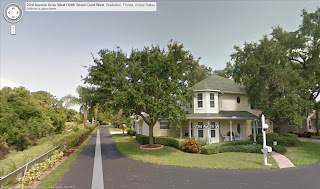Village in the Park
Located on north end commercial property
Located on north end commercial property
Last Monday night, at the commission meeting, a few north end residents presented Longboat Key with a concept proposal for a beautiful, low-density, park-like, mixed-use development, at the north gateway to the island, called Village in the Park. The concept incorporates many features from the successful Pine Avenue project in the town of Anna Maria, but in a more park-like setting.
The idea behind the Village in the Park is to give residents, visitors and shoppers a unique and compelling experience that will promote a sense of community "with benefits". Our town has a unique opportunity to develop nearly ten acres of underutilized commercial property into a social and commercial center at the north end. There are over five hundred residences within a five minute walk from this location, so it is likely to be a convenient social center for the surrounding community.
Low density, individual, two story, green structures
The concept of extending the north end village, out to Gulf of Mexico Drive, creates an opportunity to maintain current densities while enhancing the ambiance of the entire island. Unlike Pine Avenue on Anna Maria Island, this project presents fewer obstacles to achieving an Old Florida park-like atmosphere, and at the same time restoring retail amenities that have not been available to the north end community for several years.
Foot bridge connecting Center for the Arts with the mixed-use development
The concept of a neighborhood-centric mixed-used development offers Longboat Key the opportunity to create a signature accommodation on the island that will promote both business and residential activity. Several residents have advanced the idea of a public/private undertaking that includes "value capture" where surrounding residential properties benefit from being close to a beautiful park with light business and outdoor activities. The Village in the Park can be a relaxed social center for Longboat Key residents unlike existing parks that do not offer cafes or restaurants.
Village on the Park - a nice place to meet friends
Longboat Key has no other land where such a wonderful design concept can be created. For local residents, the Village in the Park will offer beach access and social amenities at one beautiful location in a natural setting.
Towles Court in Sarasota
The people promoting the Village in the Park point to the commercial success at Pine Avenue. It is their belief that combining public participation, along with beautiful design elements, will attract shoppers and develop a local following akin to the success of the Lazy Lobster and other retail -operations on the island, that do well on a year-round basis. They believe that if it is beautiful, and the amenities and businesses are attractive, the people will support the area.
Bishop's Bayou concept at Village in the Park
Above all, Village in the Park is about preserving and improving on the rare atmosphere of the village, while creating a viable retail/office/residential park setting. The proposal will protect Bishop's Bayou and expand controlled access to its beauty using mangrove walkways and intimate settings along the open water.
Bishop's Bayou setting concept
Bishop's Bayou is a beautiful place on Longboat Key that is presently completely inaccessible to the community. It has been the back alley of the Whitney Plaza for over thirty years. Village in the Park will protect and enhance this natural gem, respecting property owners while enabling a serene setting for island residents.
Casual social setting on Longboat Key
Village in the Park
Note:
Value capture refers to a type of public financing where increases in private land values generated by public investments are all or in part “captured” or recouped by the public sector. It provides a means for internalizing the positive externalities of public investments, allowing public agencies to tax the direct beneficiaries of their investments, and/or provide benefits to the taxpayers which fund the investments but do not necessarily enjoy them directly. The unearned increments, or increases in land value which otherwise profit private landowners without cost, may be captured directly by converting them into public revenue, e.g. using real estate taxes, impact fees, or other taxes levied upon landowners; or indirectly by converting them to land-related benefits, e.g. using exactions, public easements, or other nonpossessory interests granted to the public or a public agency.








